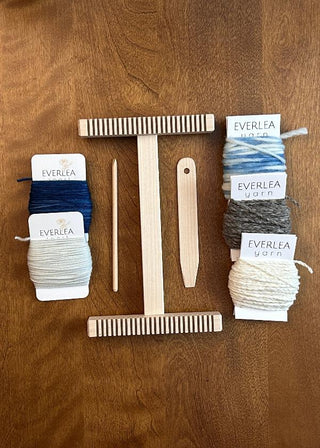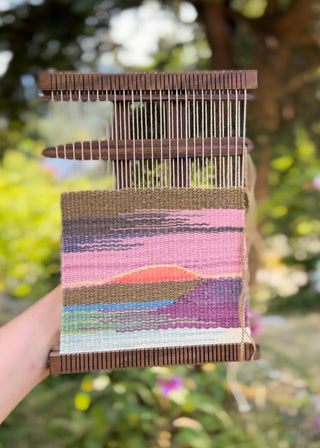
I recently scored this gorgeous handmade vintage cedar chest second hand. It needs some repair, and actually a full-on stripping one day, but I’m so happy to have found it. A cedar chest is something I’ve been wanting for years, specifically for storing my hand knits during summertime. As you can see it just so happens to be the exact right width to hold my 38” Mirrix Loom when I’m not weaving, pictured here with a tapestry in progress. It’s also the perfect volume to store my current collection of hand-knits and tapestries with a little room for growth.
I think this is the perfect opportunity to share how I will be preparing my knits to be stored, and about moth prevention in general, because, if you don’t know already, storing one's wool textiles properly in the summer is specifically a moth-prevention activity. Although it has been debated whether or not cedar wood repels moths, in my search for a cedar chest I have assumed that it does. But there are other measures that I take which are absolutely more important than having a cedar chest for storage.
So, let’s talk about moths and fibre.
There are two kinds of moths that eat textiles, ‘case-bearing moths’ and ‘webbing moths’. Both these moths require protein in their diet, so they like to eat animal fibres, also known as protein fibres. They will even eat through your cellulose fibres like cotton and linen to get to the protein. Protein may also be present in your closet in the form of food droplets/spills on your clothes, and this is most often why your cotton and linens are being eaten. So, it’s important to keep all of your clothing clean, especially when stored with important garments. If there is one dirty garment in your closet it may attract moths and compromise your whole wardrobe.
Most years when summer has arrived I hand-wash all of my winter handknits and store them in tupperware for the season. This year I get to use my new-to me wooden chest whose new home is in my studio in the basement of our home. One of the environments that moths thrive in is warmth (also why warmer seasons are the worst for moth infestations), so the fact that my winter-knits-chest is downstairs in a cooler part of the house is a bonus. Another thing to note is that moths don’t like movement. So, on summers where I haven’t gotten around to washing and storing my sweaters I make sure to take my knits out of the closet once and a while and give them a good shake. My least-used knits get this treatment even in the winter. For home decor items like wall tapestries I make sure to lift them away from the wall and wave them around a bit as part of my routine when I am doing my vacuuming and mopping.
Is your skin crawling yet? Sorry! This is not a fun topic, but an important one if you want to save your precious knits and wovens from destruction.
Let’s sum up our moth prevention protocol:
- Keep your clothing clean at all times. Clothing that’s naturally more likely to have dirt and food on them, like sweaters that get worn over and over could use a drawer of their own.
- Hand-wash your wearables which are made with animal fibres when you’re done wearing them for the season.
- Store your hand-washed animal fibre garments in a container through summer.
- If possible store them with cedar ie.in a cedar chest or with pieces of cedar wood or sachets full of cedar-chips.
- Moths prefer still environments, so if you don’t store your cold-weather wearables make sure they get moved around once and a while throughout the summer.
Additional Tip!
If you store your garments in airtight containers like ziploc bags be sure to remember to let them breathe a couple times a year. Wool fibres like to breathe and can begin to decompose due to the fact that wool naturally stores moisture, so it might not be as dry in that bag as you think and mold can begin to form. The safest protocol is to store wool in containers that are not airtight.









